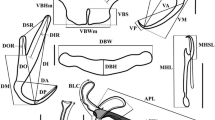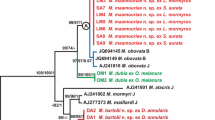Abstract
In a study of the parasites of the deep-sea fish Mora moro (Risso) (Gadiformes: Moridae) off the Mediterranean coasts of Catalonia and the Balearic Islands (Spain), we were able to distinguish two morphs of specimens belonging to Lepidapedon Stafford, 1904 (Digenea: Lepidapedidae). This material is herein described and illustrated. Comparative sequence analyses using partial mitochondrial nad1 sequences revealed that the material assigned to one of these morphs can be considered conspecific with the material identified as Lepidapedon desclersae Bray & Gibson, 1995 from the same host. However, the published nad1 sequence for L. desclersae was generated from a specimen ex M. moro from the North East Atlantic. Examination of the voucher specimens associated with this sequence revealed that both the North East Atlantic and the Mediterranean specimens ex M. moro differ from L. desclersae as described from its type-host, Lepidion eques (Günther), in the anterior extent of the vitelline fields which is further posterior, reaching only to the posterior margin of the external seminal vesicle in L. desclersae, versus being at the mid-level of this organ and reaching the posterior margin of the ventral sucker. Therefore, we have tentatively assigned the material characterised here, both morphologically and molecularly as Lepidapedon sp. Acquisition of additional sequences for both nad1 mitochondrial and 28S rRNA genes of L. desclersae from material ex Lepidion spp. is required in order to determine whether the observed morphometric variation reflects host-related or inter-specific differences. The second morph of Lepidapedon from M. moro is described and distinguished on morphometric grounds, such as the position of the most anterior vitelline follicles, which reach to the anterior margin of the ventral sucker. Its identity is commented upon, but, in view of the fact that there were few specimens and no molecular data available, it is not named.



Similar content being viewed by others
References
Blend, C. K., Dronen, N. O., & Armstrong, H. W. (2000). Six new species of Lepidapedon Stafford, 1904 (Digenea: Lepocreadiidae) from deep-sea macrourid fishes from the Gulf of Mexico and Caribbean Sea, with revised keys to the species of the genus. Systematic Parasitology, 45, 29–51.
Bray, R. A., & des Clers, S. A. (1992). Multivariate analyses of metrical features in the Lepidapedon elongatum (Lebour, 1908) species-complex (Digenea: Lepocreadiidae) in deep and shallow water gadiform fishes of the NE Atlantic. Systematic Parasitology, 21, 223–232.
Bray, R. A., & Gibson, D. I. (1989). The Lepocreadiidae (Digenea) of fishes from the north-east Atlantic: review of the genus Neolepidapedon Manter, 1954, with a description of N. smithi n. sp. Systematic Parasitology, 13, 11–23.
Bray, R. A., & Gibson, D. I. (1995). The Lepocreadiidae (Digenea) of fishes of the north-east Atlantic: a review of the genus Lepidapedon Stafford, 1904. Systematic Parasitology, 31, 81–132.
Bray, R. A., & Gibson, D. I. (1997). The Lepocreadiidae Odhner, 1905 (Digenea) of fishes from the north-east Atlantic: summary paper, with keys and checklists. Systematic Parasitology, 36, 223–228.
Bray, R. A., Littlewood, D. T. J., Herniou, E. A., Williams, B., & Henderson, R. E. (1999). Digenean parasites of deep-sea teleosts: a review and case studies of intrageneric phylogenies. Parasitology, 119 (Supplement), S125–S144.
Bray, R. A., Waeschenbach, A., Cribb, T. H., Weedall, G. D., Dyall, P., & Littlewood, D. T. J. (2009). The phylogeny of the Lepocreadioidea (Platyhelminthes, Digenea) inferred from nuclear and mitochondrial genes: implications for their systematics and evolution. Acta Parasitologica, 54, 310–329.
Bruce, N. L., Adlard, R. D., & Cannon, L. R. G. (1994). Synoptic checklist of ascaridoid parasites (Nematoda) from fish hosts. Invertebrate Taxonomy, 8, 583–674.
Gaevskaya, A. V. (1995). Lepidapedon cambrensis (Trematoda: Lepocreadiidae) parasite of the Atlantic Ocean fishes. Parazitologiya, 29, 26–29 (In Russian).
Lopez-Roman, R., & Maillard, C. (1973). Lepidapedon (Lepidapedon) guevarai n. sp. (Digenea Lepocreadiidae) parasito de Phycis blennoides (Brünnich) (Gadidae). Revista Ibérica de Parasitologia, 33, 617–624.
Morgan, J. A., & Blair, D. (1998). Mitochondrial ND1 gene sequences used to identify echinostome isolates from Australia and New Zealand. International Journal for Parasitology, 28, 493–502.
Nolan, M. J., & Cribb, T. H. (2005). The use and implications of ribosomal DNA sequencing for the discrimination of digenean species. Advances in Parasitology, 60, 101–163.
Orecchia, P., & Paggi, L. (1978). Aspetti di sistematica e di ecologia degli elminti parassiti di pesci marini studiata presso l’Istituto di Parassitologia dell’Università di Roma. Parassitologia, 20, 73–89.
Stefanescu, C., Morales-Nin, B., & Massuti, E. (1994). Fish assemblages on the slope in the Catalan sea (western Mediterranean): influence of a submarine canyon. Journal of Marine Biological Association of the United Kingdom, 74, 499–512.
Tamura, K., Peterson, D., Peterson, N., Stecher, G., Nei, M., & Kumar, S. (2011). MEGA5: Molecular evolutionary genetics analysis using maximum likelihood, evolutionary distance, and maximum parsimony methods. Molecular Biology and Evolution, 28, 2,731–2,739.
Telford, M. J., Herniou, E. A., Russell, R. B., & Littlewood, D. T. J. (2000). Changes in mitochondrial genetic codes as phylogenetic characters: two examples from the flatworms. Proceedings of the National Academy of Sciences, 97, 11,359–11,364.
Waterman, P. B., & Sin, F. Y. T. (1991). Occurrence of the marine tapeworms, Hepatoxylon trichiuri and Hepatoxylon megacephalum, in fishes from Kaikoura, New Zealand. New Zealand Natural Sciences, 18, 71–73.
Acknowledgments
We thank two anonymous reviewers for their comments and suggestions. This study was supported by the Spanish Ministry of Science and Innovation (MICINN) Project ANTROMARE (CTM2009-12214-C02-02), the Czech Science Foundation (Projects P505/10/1562 and P505/12/G112 to AK and SG), the Grant Agency of the University of South Bohemia (GAJU) (Project 04-135/2010/P to SG) and the Institute of Parasitology, České Budějovice (RVO 60077344). APO benefited from a Grant from the Xarxa de Referència de R+D+I en Aqüicultura.
Author information
Authors and Affiliations
Corresponding author
Rights and permissions
About this article
Cite this article
Dallarés, S., Georgieva, S., Kostadinova, A. et al. Morphometric and molecular characterisation of specimens of Lepidapedon Stafford, 1904 (Digenea: Lepidapedidae) from the deep-sea fish Mora moro (Risso) (Teleostei: Moridae) in the western Mediterranean. Syst Parasitol 85, 243–253 (2013). https://doi.org/10.1007/s11230-013-9426-7
Received:
Accepted:
Published:
Issue Date:
DOI: https://doi.org/10.1007/s11230-013-9426-7




